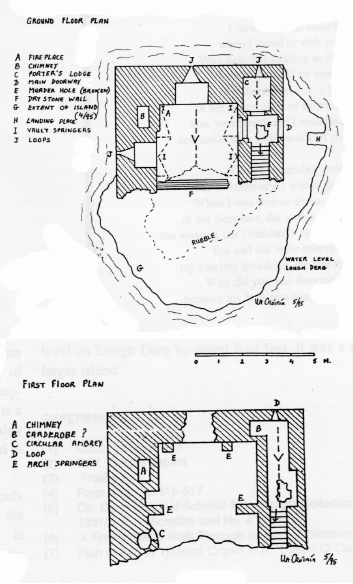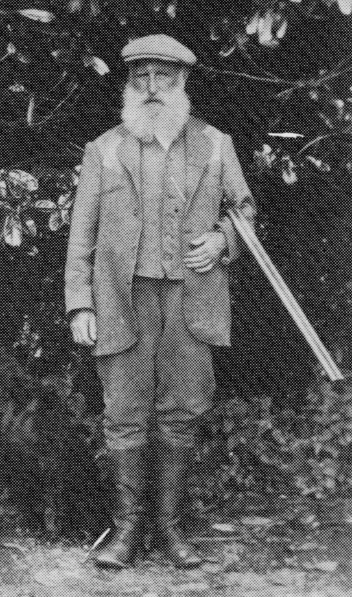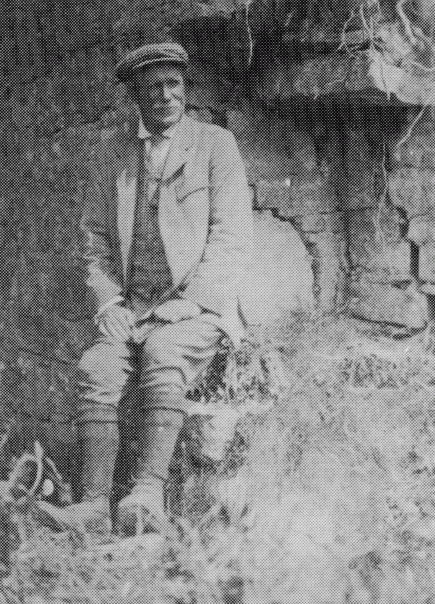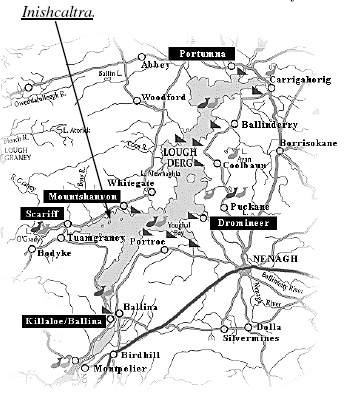Nestling on a small island on Lough Derg, close to the County Clare shoreline in the townland of Carroweena is the ruin of a sixteenth century towerhouse, known by a number of names - including Castlebawn, Bally Kelly, Belkelly, and Simon’s Castle. It was built by the dominant McNamara family during the mid to late sixteenth century, and remained in their ownership until the Cromwellian confiscations of the mid seventeenth century.

Simon’s Castle (as it is best known to local residents of the area even to this day) is best known for its siege by Government forces in 1827. According to the local historians, as recorded by the Folklore Commission of 1937/8:
In 1827 it was the scene of a dramatic siege. At that time it was the property of Major Purdon and had long been a place of illicit spirit manufacture. Several efforts by the law had proved useless in halting the distillery. However, things were now at a head and the law was determined to put an end to the unlawful spirits. Cannon had previously been tried and it was decided that the only way to clear out the men inside was to surround the castle in boats and stay there until the distillers gave in. At first they were very determined and claimed that they would fight to the end, but eventually Major Purdon and the 93rd regiment under Lieutenant Sutherland from Killaloe talked the illegal occupants into surrender. About a month later the castle was blown up by a Limerick regiment by order of the Government.
The explosion completely destroyed the South wall, and brought down the roof. Attempts to destroy the North wall failed, only managing to blow cavities in the wall without toppling it. The result is a three walled castle, looking like a medieval handball alley, sheltered by a vaulted roof.
The castle is unusual in plan from other towerhouses built during the latter half of the sixteenth century. The front door is not at ground level as one might expect, but is on the first floor, where an attacker might find it more difficult to gain access, which was probably a sign of the times. The three remaining walls have no evidence of having windows on the ground floor, so one can assume that no window existed in the south wall. This would have made the ground floor very dark leaving it only useful as a store.
The island that remains today is quite small, being only about one tenth of an acre. Prior to the building of the hydro-electric power station at Ardnacrusha in 1929 and the subsequent raising of the water level on Lough Derg by about four feet, it was a much larger island.

The eponymous "Simon" was Simon Flannery, who spent many years employed as gamekeeper on the nearby Raheen estate owned by the family of Dr. Edward MacLysaght (the first Chief Herald of Ireland). The RC parish register for Kilnoe and Tomgraney in the diocese of Killaloe records the baptism of Simon Flannery on 28th May 1853; the son of Daniel Flannery and Catherine Kinlan of Belkelly. The 1901 census returns record a Simon Flannery, gamekeeper, aged 45, living in the townland of Maryfort or Lismeehan in the division of Tulla in County Clare. If the parish register is correct, then Simon would have been a fit 48 year old at the time - but 45 was probably a close enough guess at the time!
The brothers Simon and David Flannery had a profound influence on the young Edward MacLysaght in 1909, and he sketched their characters with affectionate detail in his published work as follows:
When Dave Flannery was brought back to the job of gamekeeper, the poachers faced a different situation, for he had a reputation for toughness which stood him in good stead: had he not shot Jack Donelan and he snaring rabbits and done six weeks for it in the eighties? Dave was an unusual type, taciturn and forbidding in manner and unwont to mix with the neighbours. Yet his family is no intruding breed, for they even have right of burial on the island of Inishcaltra in Lough Derg (better known as Holy Island).
I learned the finer points of wildfowling which I extol there from a remarkable character Simon Flannery by name. Ex-gamekeeper, ex-soldier, ex-adventurer, there was little this brother of Dave's did not know about fishing and shooting. No other country but Ireland could have produced Simon; no other country in the world could have offered him the sporting life he had for the last twenty years of his life.
Looking east from our woods you see a little distance from the shore of the lake a square stone mass rising out of the water, its lichen-covered wall glimmering almost like gold. It is Belkelly Castle.
The rock on which it is built is not more than a hundred yards from the shore and in summer when the reeds are thick it looks from a distance like a little peninsula. At its base the castle is shattered just as a hayrick which cattle have broken into is eaten away at the bottom. This marked the futile attempt of the excise men to blow up the castle when a hundred years ago it was used for illicit distilling; but sixteenth century masonry could defy nineteenth century explosives.

The southern wall, however, is no longer standing; I do not know when it fell. On its grassy ruins you mount to the first floor where Simon lived. In the open hall he had his kitchen, a wigwam built of sticks and thatch around the great yawning fireplace. For bedroom he used a narrow cell just wide enough to sleep in, ventilated by the stone doorway at his feet as he lay full length in his blankets. There was a rickety ladder by which the more daring of his friends could mount to the top of the building to look out across the lake: the old circular stairway has disappeared. His valuables were stored in a big black trunk in the open hall outside: flies, hooks, lines, Sunday clothes, razor and the rest. The piece of broken looking-glass stood with its face to the wall "the way that old lad of a blackbird wouldn't be losing his day pecking at himself in the glass".
Small as it is, birds of various kinds - duck, coot, waterhen and his blackbird - used to build on Simon's tiny island, though they must have been constantly disturbed by his passage from his dwelling to his boat and back. The blackbird seemed to be a great pet though I could never see him except at a distance since seemingly he knew me for a stranger.
Simon had an abundance of anecdotes and an astonishingly varied vocabulary. He was the original of Alban O'Brien in my novel "The Gael". I made old Alban an Irish speaker. The real Simon, however, had no Irish at all beyond the amount which every dweller in the west of Ireland has, often without knowing it. I asked Dave Flannery had he Irish and he replied somewhat haughtily that he was "reared among the gentry", though he admitted that both his father and mother had used Irish more naturally than English as their language. Now Simon was Dave's brother and we must forgive this deficiency of his by registering it as a grievance against the ascendancy whom Dave meant to extol! Their parents were Irish speakers and most of Dave's children were tolerably good in their turn, the intermediate generation alone being ignorant of the native language; Dave's answer is comment enough on the spirit of their time.
Simon must not die unrecorded in some page of the world's writings. In truth no man ever appeared less likely to die than did Simon at that time. He was about fifty-five years of age; tall, upright and as tough as iron. I suppose he was one of the happiest men in the world - had he not congenial occupation, independence, the best of health and complete freedom from worry, four of the essentials of happiness. To most people the shelter he contrived for himself in the castle would appear intolerably bare and exposed even in summer, and Simon, though he cared nothing for such discomforts, seemed conscious that they were obvious to the sophisticated.
"Amn't I a queer class of a fella to be living in the like of that place: begor, I'm a wonder," he was fond of saying; and it was no bluff, for it sheltered him through twenty winters on the storm-swept lake.
I remember he used to abuse the poaching community and also the gentry of Clare (in his knickerbockers and stockings and tweed coat he looked very much like one of them himself); the latter as "beggarly paupers" who were of no use to the country, the former as spoilers of honest sport, by which he himself lived.
Simon was in his best form on one occasion when the postman had failed to deliver a parcel of fish-hooks he was expecting. The man was not supplied with a boat and could not swim even if he had succeeded in threading his way through the maze of little fields and furze-covered waste which divides that shore of the lake from the nearest road.
"There's a bloody woman called Victoria" roared Simon, and I remembered that he had once been a soldier in India. "I gave her ten of the best years of my life and now she'll not as much as send her amadán of a servant boy to me with what he has a right to bring." This sentence had an almost majestic ring about it when it was uttered in mid lake across the twenty yards or so separating our boats as naturally as an ordinary voice crosses a dining table.
Quite unexpectedly he got an army pension a few years after he had taken to life on the lake. A chance meeting with another ex-soldier who was an itinerant fiddler led to his applying for it. I was with him when he filled in the War Office application form and in spite of my advice I remember his reply to a question regarding his conduct while in the army was the single word "Bad".

My final memory of this remarkable man is that romantic journey of his when his funeral cortčge made its way across the lake in boats to lay him to rest in the family burial place beside one of the "seven churches" on the island of Inishcaltra.

The castle has recently been restored by its current owner, Pat Cody, and is used as a summer residence.

[illustrations courtesy of Pat Cody; Slieve Aughty (East Clare Heritage) Journal #8, 1998; and "Changing Times; Ireland since 1898" by Edward MacLysaght, 1978]